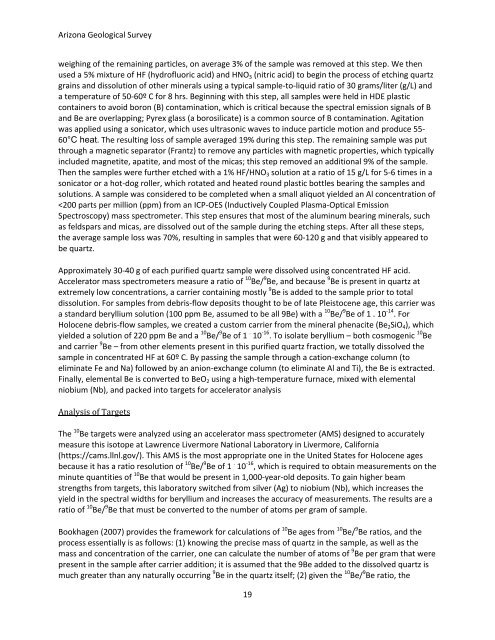Arizona Geological Survey OPEN-FILE REPORT OFR 08-06
Arizona Geological Survey OPEN-FILE REPORT OFR 08-06
Arizona Geological Survey OPEN-FILE REPORT OFR 08-06
Create successful ePaper yourself
Turn your PDF publications into a flip-book with our unique Google optimized e-Paper software.
<strong>Arizona</strong> <strong>Geological</strong> <strong>Survey</strong><br />
weighing of the remaining particles, on average 3% of the sample was removed at this step. We then<br />
used a 5% mixture of HF (hydrofluoric acid) and HNO 3 (nitric acid) to begin the process of etching quartz<br />
grains and dissolution of other minerals using a typical sample‐to‐liquid ratio of 30 grams/liter (g/L) and<br />
a temperature of 50‐60º C for 8 hrs. Beginning with this step, all samples were held in HDE plastic<br />
containers to avoid boron (B) contamination, which is critical because the spectral emission signals of B<br />
and Be are overlapping; Pyrex glass (a borosilicate) is a common source of B contamination. Agitation<br />
was applied using a sonicator, which uses ultrasonic waves to induce particle motion and produce 55‐<br />
60°C heat. The resulting loss of sample averaged 19% during this step. The remaining sample was put<br />
through a magnetic separator (Frantz) to remove any particles with magnetic properties, which typically<br />
included magnetite, apatite, and most of the micas; this step removed an additional 9% of the sample.<br />
Then the samples were further etched with a 1% HF/HNO 3 solution at a ratio of 15 g/L for 5‐6 times in a<br />
sonicator or a hot‐dog roller, which rotated and heated round plastic bottles bearing the samples and<br />
solutions. A sample was considered to be completed when a small aliquot yielded an Al concentration of<br />
















